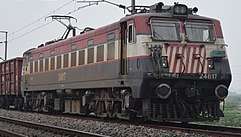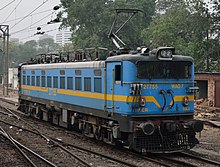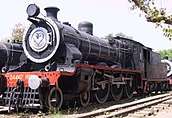Indian locomotive class WAG-7
The Indian locomotive class WAG-7 is a class of 25 kV AC electric locomotives that was developed in the 1990 by Chittaranjan Locomotive Works for Indian Railways. The model name stands for broad gauge (W), AC Current (A), Goods traffic (G) engine, 7th generation (7). They entered service in 1992. A total of 1970 WAG-7 were built at CLW and BHEL between 1990 to 2015, which made them the most numerous class of mainline electric locomotive till its successor the WAG-9.
| WAG 7 / 7H | |||||||||||||||||||||||||||||||||||||||
|---|---|---|---|---|---|---|---|---|---|---|---|---|---|---|---|---|---|---|---|---|---|---|---|---|---|---|---|---|---|---|---|---|---|---|---|---|---|---|---|
.jpg) MGS WAG-7 running light towards Gurpa | |||||||||||||||||||||||||||||||||||||||
| |||||||||||||||||||||||||||||||||||||||
| |||||||||||||||||||||||||||||||||||||||
| |||||||||||||||||||||||||||||||||||||||
| |||||||||||||||||||||||||||||||||||||||
The WAG-7 is one of the most successful locomotives of Indian Railways currently serving both freight and passenger trains for over 28 years. Even though with advent of new 3-phase locomotives like WAG-9 and WAG-12, all WAG-7 locomotives except one destroyed in accidents, rest are in service and doing all types of duties.
History
The history of WAG-7 begins in early 1990s with the aim of addressing the shortcomings of the previous WAG-5 class and remove steam locomotives from IR by a target date of 1990.[3] The WAG-5 though were great successes, had became underpowered to meet the growing demands of the Indian Railways. So in early 1990s IR decided to look for a successor the WAG-5 class. The required specification was of a 5000 horsepower locomotive.
Initially, the Indian railways invited tenders to build locomotives to the new specification. The following responses were received:
- CLW submitted their upgraded WAG-5 model with 5000 hp with Co-Co bogies.
- BHEL submitted a 5000hp locomotive with thyristors control and Co-Co bogies.
Each company submitted their prototypes and Indian Railways designated these prototypes as the WAG-7 class and WAG-8 class respectively.[4] Technologically thyristor controlled BHEL WAG-8 was meant to be superior to the WAG-7 which was effectively using tap-changer technology from the 1960s. But due to issues from WAG-8, WAG-7 was selected for mass production.
However, even before the WAG-7 another type of electric locomotive was imported from ASEA in 1988. This locomotive was classified as WAG-6A. However WAG-6As were not selected for mass production because emergence of 3 Phase AC locomotives.[5]
Production History
On 3 August 1992, the first WAG-7 locomotive was inaugurated and christened by Mother Teresa as "SHANTIDAN". After undergoing trials the first 71 of this class were homed at Mughalsarai (MGS) shed and latter ones at Kanpur (CNB). Some units are retrofitted with Static Converters(STC) instead of Arno Rotary Converters. STCs are more efficient and require less maintenance. Also, STCs have self diagnostics making troubleshooting easier. WAG-7H is a heavy variant of WAG-7. WAG-7H #28739 has thicker under-frames. WAG-7 #27445 has closed-circuit cameras to monitor the pantograph along with a spotlight to illuminate the same at night, green lamps to exchange signals and a single windscreen on either side. New Katni (NKJ) shed has added Overhead Equipment(OHE) monitors. Some WAG-7 units have A.C. cabs, SIV, MPFDCS, MPCS, Single arm pantograph, FDCS, Additional COC, Rear-view mirrors, STS, Daulat Ram's Roof-mounted DBRs, SI, Modified ceilings, Bucket seats, Waist-level headlamps, High-reach pantographs, Vigilance Control Device(VCD), Wireless Multiple Control, Vertical Dynamic Brake Resistor(DBR) and microprocessor control. Some units have their MU cables removed. One unit has SCHUNK pantograph. Some units are assembled at Dahod Workshops. Initially WAG-7 had the body-shell similar to WAG-5 but later on all WAG-7 are/were fitted with crew safe shell like the WAP-4 since this provided more space and relatively safer during the impact on a head-on collision. WAG-7H have crew safe shell since beginning. Older WAG-7s have Tiger Face liveries (Red/Dark Blue on white) but newer WAG-7s by CLW have yellow stripe on blue livery. All BHEL built WAG-7s have Tiger Face livery. Now, even some older WAG-7s are repainted with yellow stripe on blue livery. It is also the most powerful indigenously designed freight-dedicated locomotive in India.
Technical Specifications
Instead of the ALCO asymmetric trimount Co-Co bogies used in WAG-5 and WAM-4 locomotives, the WAG-7 was given high-adhesion Co-Co bogies ( a modified indigenous variant of the WAG-6 bogies). They also had the Hitachi HS15250A seen in present day WCAM-3 and WCAG-1.
| Traction Motors | a variant of the standard HS15250 with higher current rating (thicker wire gauge, better insulation); Motors built by CLW and BHEL. 6 motors in parallel grouping |
| Traction Motors Class of Insulation for Armature and Field | C |
| Traction Motors Suspension | Axle hung and Nose-suspended |
| Traction Motors Weight | 3,650 kg (8,050 lb) |
| Traction Motors Temperature rise in Armature | 90 degrees Celsius (194 degrees Fahrenheit) |
| Traction Motors Temperature Rise in Field | 70 degrees Celsius (158 degrees Fahrenheit) |
| Traction Motors Temperature rise in Commutator | 85 degrees Celsius (185 degrees Fahrenheit) |
| Traction Motors Coil resistance at 110 degrees Celsius (230 degrees Fahrenheit) of Armature | 0.0126 ohms |
| Traction Motors Coil resistance at 110 degrees Celsius (230 degrees Fahrenheit) of Main pole | 0.0117 ohms |
| Traction Motors Coil resistance at 110 degrees Celsius (230 degrees Fahrenheit) of Inter pole | 0.0089 ohms |
| Traction Motors Continuous rating | 630 kW (840 hp), 750 V, 900 A, 895 rpm |
| Traction Motors rating for 1 hour | 670 kW (900 hp), 750 V, 960 A, 877 rpm |
| Traction Motors Air gap for Main pole | 6.35 mm (0.250 in) |
| Traction Motors Air gap for Inter pole | 10 mm (0.394 in) |
| Gear Ratio | WAG-7 : 65:16 and 18:64 and WAG-7H : 65:16 |
| Transformer | CCL India, type CGTT-5400, Primary rating (5670 kVA, 252 A) Secondary rating (5400 kVA, 1000 V, 5400 A), Tertiary rating 270 V, 32 taps, 12,200 kg (26,900 lb), Forced Oil cooling, Class A Insulation |
| Rectifiers | Two silicon rectifiers, cell type S18FN350 (from Hind Rectifier), 64 per bridge, Continuous rating 2700 A / 1050 V per cubicle, Max starting current 3300 A, Forced air cooling |
| Pantographs | Two Stone India (Calcutta) type AM-12, 235 kg (518 lb) including 4 insulators |
| Bogie drive arrangement | Gear pinion |
| Current Ratings | 1350 A/2min, 1200 A/10min, 960 A/hr, 900 A continuous |
| Number of sandboxes | 8 |
| Permanent shunt | 5% |
| 2 Headlights | 32 V, 50 W |
| Lead Acid batteries | 50 cells, 110 V(5 hour rating) |
| Arno Converter Input | 216 kVA, 415 V, 1 phase 520 A |
| Arno Converter Out put | 150 kVA, 415 V, 3 phase 210 A, 1485 rpm |
| 2 TRC-2000 type Compressors by Elgi | 10.5 kg/cm2 (149 psi) |
| 2 Compressor Motors | 30 hp (22 kW), 415 V, 930 rpm |
| 2 Exhauster Motors | 7.5 kW (10.1 hp), 415 V, 970 rpm |
| 2 250 RE type Exhausters by Northey | 4,500 L/min (990 imp gal/min; 1,200 US gal/min) |
| 2 SF India Ltd. Traction Motor Blowers | 276 m3/min (9,700 cu ft/min) |
| 2 Traction Motor Blower Motors by Siemens | 415 V, 26 kW (35 hp), 50 A, 2920 rpm |
| 2 PFT-59 type Smoothing Reactors by SF India Ltd. | 4,200 m3/min (150,000 cu ft/min) |
| 2 Smoothing Reactor Motors | 2.2 kW (3.0 hp), 415 V, 2860 rpm |
| 2 KDBR-1 type Breaking Resistor Blowers by KEC International | 510 m3/min (18,000 cu ft/min) |
| Breaking Resistor Blower Motor | 30 kW (40 hp), 450 V, 76 A DC, 3300 rpm |
| Brushes grade | EG1055/BG 1165 (Margnite) |
| Brushes type | 2 split |
| Brushes size | 200 mm × 40 mm × 64 mm (7.874 in × 1.575 in × 2.520 in) |
| Brushes Wear limit | 25 mm (0.984 in) |
| 2 PHMX-40-6 type Rectifier Blowers by SF India Ltd. | 3,100–3,200 m3/h (110,000–110,000 cu ft/h) |
| 2 Rectifier Blower Motors | 2.2 kW (3.0 hp), 415 V, 4.8A, 2860 rpm |
| MLBH-60-1-H2 type Coil Cooler Blower by SF India Ltd. | 22,200 m3/h (780,000 cu ft/h) |
| Coil Cooler Blower Motor | 22 kW (30 hp), 415 V, 45 A, 1450 rpm |
| Oil Pump by Best & Co. Pvt. Ltd. | 730 L/min (160 imp gal/min; 190 US gal/min) |
| Oil Pump Motor | 32 kW (43 hp), 415 V, 2865 rpm |
| 2 SL 30 type Smoothing Reactors | 1250 V, 1350 A |
| Smoothing Reactor Resistance at 110 degrees Celsius (230 degrees Fahrenheit) | 0.00344 ohms |
Locomotive sheds
| Zone | Name | Shed Code | Quantity |
|---|---|---|---|
| Central Railway | Ajni | AQ | 48 |
| Kalyan | KYN | 56 | |
| Eastern Railway | Asansol | ASN | 35 |
| East Central Railway | Pt. DD Upadhyaya Junction | DDU | 120 |
| DDU (D) | 50 | ||
| Gomoh | GMO | 2 | |
| East Coast Railway | Angul | ANGL | 216 |
| Northern Railway | Ludhiana | LDH | 55 |
| LDH(D) | 51 | ||
| Khanalampura | KJGY | 58 | |
| North Central Railway | Jhansi | JHS | 90 |
| Kanpur | CNB | 77 | |
| North Eastern Railway | Gonda | GD(D) | 55 |
| Southern Railway | Erode | ED | 98 |
| ED(D) | 24 | ||
| South Central Railway | Vijayawada | BZA | 112 |
| Kazipet | KZJ | 120 | |
| KZJ(D) | 30 | ||
| Guntakal | GTL(D) | 40 | |
| South Eastern Railway | Tatanagar | TATA | 39 |
| Bondamunda | BNDM | 126 | |
| Bokaro Steel City | BKSC | 80 | |
| BKSC (D) | 60 | ||
| Kharagpur | KGP(D) | 50 | |
| South East Central Railway | Bhilai | BIA | 118 |
| Western Railway | Valsad | BL | 68 |
| West Central Railway | New Katni Jn. | NKJ | 81 |
| Total Locomotives Active as of 01-08-2020[6] | 1959 | ||
Performance
WAG-7 with a gear ratio of 18:64 has the following capacity while hauling BOX wagons (in tonnes):
| Level/Grade | Start | 20 Unit? | 30 | 40 | 50 | 60 | 70 | 80 | 90 | 100Unit? |
|---|---|---|---|---|---|---|---|---|---|---|
| Level | 7500+ | 7500+ | 7500+ | 7500+ | 7500+ | 7500+ | 7500+ | 7500+ | 5236 | 3732 |
| 1 in 500 | 5859 tonnes? | 5859 | 5859 | 5859 | 5859 | 5765 | 4555 | 3808 | 2714 | 2003 |
| 1 in 200 | 4065 | 4065 | 4065 | 4065 | 3982 | 3125 | 2510 | 2135 | 1540 | 1148 |
| 1 in 150 | 3468 | 3330 | 3272 | 3210 | 3145 | 2476 | 1995 | 1703 | 1229 | 916 |
| 1 in 100 | 2669 | 2294 | 2265 | 2234 | 2201 | 1736 | 1401 | 1198 | 861 | 638 |
| 1 in 50 | 1512 | 1149 | 1140 | 1131 | 1121 | 879 | 704 | 599 | 419 | 300 |
WAG-7 with a gear ratio of 18:64 has the following capacity while hauling BOXN wagons (in tonnes):
| Level/Grade | Start | 20 | 30 | 40 | 50 | 60 | 70 | 80 | 90 | 100 |
|---|---|---|---|---|---|---|---|---|---|---|
| Level | 7500+ | 7500+ | 7500+ | 7500+ | 7500+ | 7500+ | 7500+ | 7500+ | 5404 | 3793 |
| 1 in 500 | 6836 | 6836 | 6836 | 6836 | 6836 | 6016 | 4712 | 3904 | 2759 | 2021 |
| 1 in 200 | 4516 | 4433 | 4328 | 4209 | 4088 | 3198 | 2558 | 2166 | 1555 | 1154 |
| 1 in 150 | 3790 | 3425 | 3361 | 3288 | 3212 | 2523 | 2026 | 1723 | 1238 | 920 |
| 1 in 100 | 2859 | 2340 | 2308 | 2272 | 2233 | 1759 | 1416 | 1208 | 866 | 640 |
| 1 in 50 | 1575 | 1161 | 1152 | 1141 | 1130 | 885 | 708 | 602 | 420 | 300 |
WAG-7 with a gear ratio of 65:16 has the following capacity while hauling BOXN wagons (in tonnes):
| Level/Grade | Start | 20 | 30 | 40 | 50 | 60 | 70 | 80 | 90 | 100 |
|---|---|---|---|---|---|---|---|---|---|---|
| Level | 10815 | 7500+ | 7500+ | 7500+ | 7500+ | 7500+ | 7500+ | 7302 | 4619 | 2785 |
| 1 in 500 | 7169 | 7169 | 7169 | 7169 | 7169 | 6192 | 5005 | 3465 | 2345 | 1465 |
| 1 in 200 | 4738 | 4738 | 4738 | 4738 | 4085 | 3285 | 2715 | 1915 | 1295 | 820 |
| 1 in 150 | 3977 | 3960 | 3880 | 3795 | 3210 | 2590 | 2150 | 1515 | 1020 | 645 |
| 1 in 100 | 3002 | 2705 | 2665 | 2625 | 2225 | 1805 | 1500 | 1055 | 725 | 450 |
| 1 in 50 | 1700 | 1345 | 1335 | 1320 | 1120 | 905 | 750 | 515 | - | - |
WAG-7H has the following capacity while hauling BOX wagons (in tonnes) :
| Level/Grade | Start | 20 | 30 | 40 | 50 | 60 | 70 | 80 |
|---|---|---|---|---|---|---|---|---|
| Level | 6000+ | 6000+ | 6000+ | 6000+ | 6000+ | 6000+ | 6000+ | 6000+ |
| 1 in 500 | 6000+ | 6000+ | 6000+ | 6000+ | 6000+ | 5930 | 4835 | 3380 |
| 1 in 200 | 4350 | 4350 | 4350 | 4350 | 4040 | 3210 | 2665 | 1885 |
| 1 in 150 | 3710 | 3710 | 3710 | 3705 | 3245 | 2545 | 2115 | 1500 |
| 1 in 100 | 2855 | 2655 | 2620 | 2580 | 2195 | 1780 | 1485 | 1045 |
| 1 in 50 | 1660 | 1330 | 1320 | 1310 | 1110 | 895 | 745 | 510 |
WAG-7H has the following capacity while hauling BOXN wagons (in tonnes) :
| Level/Grade | Start | 20 | 30 | 40 | 50 | 60 | 70 | 80 |
|---|---|---|---|---|---|---|---|---|
| Level | 6000+ | 6000+ | 6000+ | 6000+ | 6000+ | 6000+ | 6000+ | 6000+ |
| 1 in 500 | 6000+ | 6000+ | 6000+ | 6000+ | 6000+ | 6000+ | 5005 | 3465 |
| 1 in 200 | 4835 | 4835 | 4835 | 4835 | 4085 | 3285 | 2715 | 1915 |
| 1 in 150 | 4135 | 3960 | 3880 | 3795 | 3210 | 2590 | 2150 | 1515 |
| 1 in 100 | 3060 | 2705 | 2665 | 2625 | 2225 | 1805 | 1500 | 1055 |
| 1 in 50 | 1730 | 1345 | 1335 | 1320 | 1120 | 905 | 750 | 515 |
Image Gallery
 Compare the two different classes with exactly the same horsepower and almost similar shells
Compare the two different classes with exactly the same horsepower and almost similar shells BHEL made Erode WAG-7 (TigerFace) locomotive with freight train
BHEL made Erode WAG-7 (TigerFace) locomotive with freight train WAG-7 (old variant) belonging to Electric Loco Shed, Kazipet
WAG-7 (old variant) belonging to Electric Loco Shed, Kazipet.jpg) Jhansi based WAG 7 loco - 27072 with BTPN (Tank-car rakes)
Jhansi based WAG 7 loco - 27072 with BTPN (Tank-car rakes)_with_a_Freight_train.jpg) Lallaguda WAG-7 (28068) with a Freight train
Lallaguda WAG-7 (28068) with a Freight train WAG-7 (27486) of Erode with a freight train at Pithapuram
WAG-7 (27486) of Erode with a freight train at Pithapuram WAG 7 locomotive of Mughalsarai shed
WAG 7 locomotive of Mughalsarai shed A WAG 7 loco of New Katni Junction Loco shed
A WAG 7 loco of New Katni Junction Loco shed WAG-7 class electric locomotive of Indian Railways
WAG-7 class electric locomotive of Indian Railways.jpg) VSKP - SC Special with a WAG7 loco incharge
VSKP - SC Special with a WAG7 loco incharge WAG-7 locomotive of Valsad (BL) Shed
WAG-7 locomotive of Valsad (BL) Shed WAG-7 of Kanpur (CNB) shed
WAG-7 of Kanpur (CNB) shed Bondamunda(BNDM) based WAG-7 (old varient) at Toranagallu Junction
Bondamunda(BNDM) based WAG-7 (old varient) at Toranagallu Junction
See also
References
- "Trainweb WAG-7".
- "Trainweb WAG-7H".
- "Report of the expert Committee on Coal Consumption on Railways, 1958". INDIAN CULTURE. Retrieved 29 April 2020.
- "[IRFCA] Indian Railways FAQ: Locomotives - General Information - I". www.irfca.org. Retrieved 18 April 2020.
- "The WAG Series". 24 Coaches. 30 October 2013. Retrieved 29 April 2020.
- "e-Locos".
External links
| Wikimedia Commons has media related to Indian locomotive class WAG7. |



